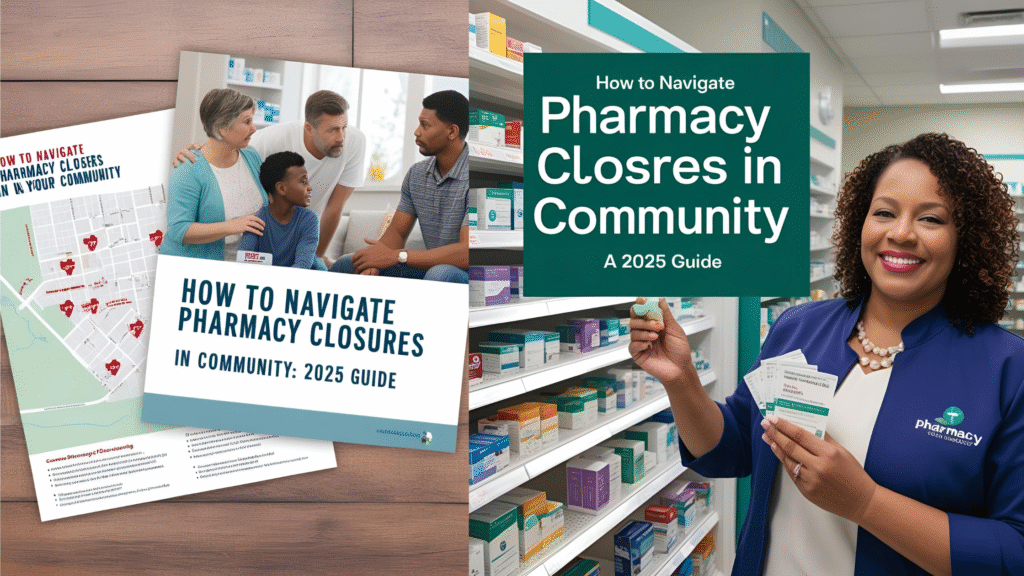Protecting access to medications and care in the face of a growing crisis

Introduction: The Rising Tide of Pharmacy Closures
Pharmacy closures have surged across the U.S., with over 29% of pharmacies shuttering between 2010 and 2021, disproportionately affecting rural, low-income, and minority communities. These closures create “pharmacy deserts,” where residents must travel long distances for medications, vaccinations, and critical health services—worsening health disparities and increasing risks for chronic disease patients.
This blog outlines actionable steps to help individuals and communities adapt to closures, advocate for change, and ensure uninterrupted access to care.
1. Confirm Closure Details and Transfer Prescriptions
Step 1: Verify closure timelines.
Check the pharmacy’s website, social media, or call directly. Many chains like Rite Aid announce closures months in advance but may stop accepting returns or gift cards abruptly.
Step 2: Transfer prescriptions early.
- Use apps like CVS Pharmacy Transfer or Walgreens Prescription Refill to move prescriptions digitally.
- Contact your new pharmacy directly to streamline transfers. Pharmacies excluded from Medicare Part D “preferred networks” often close faster, so confirm your new pharmacy’s network status5.
Pro Tip: Ask your doctor for a 90-day supply of chronic medications to buffer against delays
2. Explore Alternative Pharmacy Services
Mail-Order Pharmacies:
- Benefits: Cost-effective for maintenance medications (e.g., diabetes supplies).
- Drawbacks: Limited urgent care options and reduced pharmacist interaction.
Remote Dispensing Pharmacies:
Some states allow pharmacies to operate with remote pharmacist oversight via video calls. These are expanding in rural areas to combat pharmacy deserts.
Telehealth Partnerships:
Platforms like Teladoc or GoodRx Care offer virtual consultations and electronic prescriptions, bridging gaps in care access
3. Advocate for Policy Reforms
Demand PBM (Pharmacy Benefit Manager) Reform:
PBMs often exclude independent pharmacies from insurance networks, accelerating closures. Support legislation like:
- The Protecting Pharmacies in Medicaid Act: Aims to eliminate PBM “spread pricing,” which could save Medicaid $2 billion over 10 years and redirect funds to sustain local pharmacies.
- State-Level Bans on PBM-Owned Pharmacies: Arkansas recently prohibited PBMs from owning pharmacies to curb anti-competitive practices.
Push for Pharmacist “Provider Status”:
Lobby Congress to recognize pharmacists as healthcare providers, enabling them to bill for services like vaccinations and chronic disease management—boosting revenue for struggling pharmacies
4. Support Independent Pharmacies
Independent pharmacies are stepping up to fill gaps left by chain closures. Here’s how to help:
- Choose Local Over Mail-Order: Prioritize independents for prescriptions to keep revenue in your community.
- Utilize Expanded Services: Many now offer compounding, immunizations, and home delivery. For example, Iowa-based pharmacies earn thousands annually through clinical services like medication therapy management.
- Join Community Advocacy Groups: Organizations like the National Community Pharmacists Association (NCPA) fight for fair reimbursement rates and policy changes
5. Prepare for Emergencies
Build a Medication Stockpile:
- Work with your doctor to secure a 1–2 month backup supply of essential medications.
- Use pill organizers or adherence packaging (offered by many independents) to avoid missed doses during transitions.
Map Nearby Alternatives:
Use tools like the ACT Pharmacy Collaborative map to identify surviving pharmacies in your area. Rural residents should note locations near workplaces or schools, as drive-time access is critical
6. Address Health Disparities in Pharmacy Deserts
Community Solutions:
- Mobile Clinics: Some independents deploy mobile units to provide vaccines and screenings in underserved neighborhoods.
- Pharmacy Partnerships: Churches or schools can host pop-up clinics with local pharmacists.
Policy Proposals:
Advocate for federal incentives, like supplemental fees for pharmacies operating in deserts or grants for telehealth infrastructure.
Conclusion: Turning Crisis into Opportunity
Pharmacy closures are a symptom of systemic issues—low reimbursements, PBM dominance, and unequal access—but communities can fight back. By transferring prescriptions wisely, supporting independents, and demanding policy reforms, we can protect this critical healthcare lifeline.
What next:
- Share closure stories using the hashtag #SaveOurPharmacies.
- Contact your representatives to support the Protecting Pharmacies in Medicaid Act
Pingback: Rite Aid’s Second Bankruptcy In Two Years: What Customers And Employees Need To Know (2025 Update) - Money Hans